Abstract
Orbital angular momentum (OAM) carried by bi-photon entangled Airy beams in unstable oceanic turbulence is theoretically investigated. The analytical expression of the spatial coherence radius of a spherical wave in the unstable stratification oceanic turbulence is derived to obtain the relative detection probability of bi-photon entangled Airy beams. The relative detection probability of OAM carried by bi-photon entangled Airy beams acquires significant enhancements—up to 62% compared to the same measurement for the single photon system over a distance of 100 m. Lower-order bi-photon entangled Airy beams with larger wavelengths, and main ring radius are less affected by oceanic turbulence. A larger main ring radius also contributes to reducing the fluctuations in detection probability. Oceanic turbulence dominated by salinity fluctuations induces more adverse effects on the OAM, as well as a stronger strength of the turbulence.
1. Introduction
Underwater optical communication (UOC) based on orbital angular momentum (OAM) has a high capacity due to the arbitrary base-N quantum digits [1,2,3], while oceanic turbulence in the propagation would seriously distort the helical phase structure of OAM [4], giving rise to degradation of the UOC system. Spatial power spectrum as a statistical method can describe this kind of optical turbulence [5,6,7]. Nikishov proposed an oceanic spectrum based on the common assumption that the eddy diffusivity of temperature is equal to that of salt, which implicitly assumes that seawater has a stable stratification [8]. Partly because of its relatively simple algebraic expression, Nikishov’s spectrum has been widely used in theoretical calculations [9,10,11,12]. Indeed, the eddy diffusivity of temperature and salinity are different from each other in most underwater regions [7,13], and the spatial power spectrum of turbulent fluctuations of the seawater refraction index has been given by Elamassie that includes an eddy diffusivity ratio [7]. However, Elamassie’s theory of oceanic spectrum only worked for infinity outer scale and did not include the effects of outer scale oceanic turbulence. Recently, a spatial power spectrum of unstable stratification oceanic turbulence has been proposed as an explicit function of the outer scale factor [14]. By considering the effect of the outer scale turbulence, this spectrum agrees well with the experimental data in all wavenumber regions.
On the other hand, motivated by the fact that OAM states of vortex beams are discrete, integer-valued and construct a theoretical infinite-dimensional Hilbert space [15], the entanglement of OAM has been demonstrated to carry more information in optical communication [16,17]. It is possible to obtain entangled OAM states via spontaneous parametric down-conversion [18] and transport through turbulence [19,20]. OAM entanglement not only presents an approach to enhance information capacity [21] but also promises strong robustness against decoherence effects [22] and higher security [23]. However, the transmission of OAM entanglement states in free space is challenging [20]. The entanglement of OAM would be destroyed by beam wandering, wavefront degradation and scintillation induced by turbulence [24]. There are many efforts toward OAM entanglement propagation through turbulence. By introducing the phase correlation length of Laguerre–Gaussian (LG) modes, the decay of OAM entanglement states upon propagation through atmospheric turbulence has been discussed [25]. It turns out that the entanglement of photonic OAM shows a universal exponential decay in weak turbulence. Moreover, the effects of non-Kolmogorov atmospheric turbulence on bi-photon entangled OAM states have been discussed by means of LG modes [26]. In the above studies, LG beams possessing a well-defined OAM serve as a common option for the light source. In fact, Airy beams have non-diffraction [27], autofocusing [4,28] and self-healing [29,30] properties, providing considerable potential as a bi-photon entangled UOC link. The propagation dynamic of Airy beams has been proven in simulations to mitigate the OAM degradation and reduce the crosstalk induced by turbulence [31,32]. Recently, the spatially entangled Airy bi-photon has been generated experimentally and propagated in a vacuum [33]. To apply the entangled Airy source in the UOC link, the investigation of entangled Airy beams in oceanic turbulence is imminent.
In this paper, we demonstrate the propagation of the OAM of bi-photon entangled Airy beams through unstable oceanic turbulence. The semi-classical method is extended into a bi-photon case, and the relative detection probability of bi-photon entangled Airy beams is developed. Based on the general integrals, the analytical expression of the spatial coherence radius of a spherical wave propagating in unstably stratified oceanic turbulence is derived. Analyzing the results of numerical simulations, we compare the bi-photon entangled system and non-entangled ones and study how OAM modes of the bi-photon entangled Airy beams are affected by specific parameters of beam and turbulence. Through analytical simulations under various parameter settings, entangled Airy beams show stronger robustness to oceanic turbulence than single ones.
2. Methods
The sketch of a bi-photon entangled UOC link is illustrated in Figure 1. For non-trivial subspace (), where is a general symbol for the OAM number, we assume that the initial state of the bi-photon Airy beams is an entangled Bell-like state [19,34]:
where , for the conversation of momentum, represents a single photon OAM eigenmode of an Airy mode, is the OAM quantum number corresponding to the OAM , the subscript is used to label two different channels of the two photons and and denote probability amplitudes that are subject to . As the constituent photons launched with equal probability (), the maximal entanglement occurs for the initial bi-photon.

Figure 1.
Sketch of a thought experiment involving bi-photon propagation through independent turbulence paths 1 and 2.
Using cylindrical representation and inserting the completeness relation , one can obtain the probability of the joint OAM measurement at propagation distance z as [35]
with , is the radial distance from the axis and is the two-dimensional vector. The joint OAM detection probability is then given by the ensemble average [36] of Equation (2) as
where is defined as the rotational field correlation of the bi-photon. For convenience, we set and to rewrite Equation (3) as
Generalizing the semi-classical approach [36] to bi-photon entangled case, the bi-photon entangled Airy beams is given by
where is the phase perturbation induced by turbulence, which gives rise to the crosstalk of OAM, and is the radial component of Airy beam. Substituting Equation (5) into Equation (4), the final expression of the joint detection probability is derived as
where , , and represents the circular harmonic transformation of the rotational coherence function [36].
Given to Markov approximation, we consider the turbulent channels 1 and 2 are independent [25]. The relative version of the detection probability is calculated to study the influence of oceanic turbulence on the entangled bi-photon due to the existence of the launching probability at the source plane. By partially tracing the joint detection probability , and considering the probability of launching , the relative detection probability of the signal photon reads
where is the detection probability of measuring the OAM of a single-photon Airy beam for a receiver with the aperture diameter D
for non-normalized wavefunctions, the normalization of Equation (8) must be performed via . Without a loss in generality, we shall denote that the relative detection probability for faithful propagation is (i.e., ) and the crosstalk probability that detects OAM modes is . Moreover, Equation (8) is given under Rytov approximation [5], where the effects of the oceanic turbulence on the OAM beam are simplified as only phase disturbance. Thus the application of our model is theoretically limited to the weak fluctuation region. When launching photon i with probability 1 (), the second term in Equation (7) is 0. In this case, Equation (7) is equivalent to Equation (8).
Comparing the relative detection probability of a single photon in Equation (8), an extra item comes out in Equation (7) describing the relative detection probability of a bi-photon. Take OAM state as an example, due to the detection probability always being a non-negative real number. Physically, the quantity represents the transition of an OAM state caused by oceanic turbulence, which results in the elevation of the relative probability .
For an aperture-truncated Airy beam, is given by [28]
where k is the wave number and is related to the wavelength in general by , and a are the radius of the main ring and the exponential truncation parameter, respectively, is the arbitrary transverse scale [37] and is the first-kind Bessel function of the order.
To further understand the effects of the significant parameters of Airy modes on the beam structure, the transverse intensity distributions of Airy beams in a vacuum for different , and a at the source plane () are plotted in Figure 2. The simulation is conducted by the software of Mathematica 13.0. It is clear to see that the beam size of the Airy beam increases with the increasing , and the dark spot at the center spreads with the increment of simultaneously (Figure 2b,c). Moreover, as , the intensity distribution of the Airy beam evolves into a Gaussian distribution [38], as shown in Figure 2d.
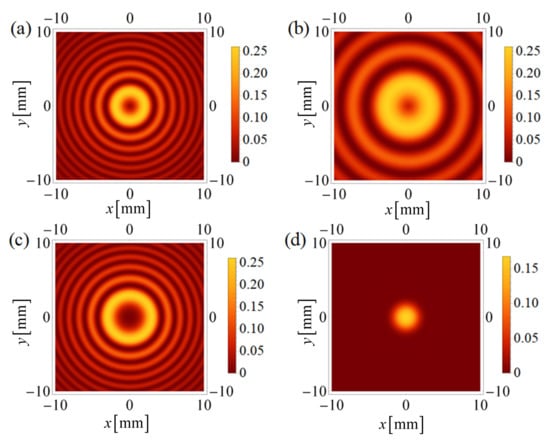
Figure 2.
Intensity distribution for Airy beams in a vacuum of different beam parameters. Compared with (a) , , , the different parameters in (b–d) are: (b) , (c) and (d) .
We now proceed to discuss how oceanic turbulence influences the OAM of bi-photon entangled Airy beams. Based on the quadratic approximation of the wave structure function [5], the circular harmonic transformation of the rotational coherence function becomes
where , and is the spatial coherence radius of a spherical wave propagating in the oceanic turbulence calculated as [3]
in Equation (11), a theoretical description of the statistical characteristics of a wave propagating through optical turbulence, denotes the power spectrum of refractive fluctuations [5,8] and is related to the magnitude of the wave number vector . In a the real ocean circumstance, the eddy diffusivity ratio of temperature to salt is not equal to unity. When unstable stratification exists, and outer scale effects cannot be ignored in oceanic turbulence, the spectrum is given by [14]
where refers to temperature fluctuations, salinity fluctuations and coupling fluctuations, and are dimensionless constants that vary with different “j”, is the spatial cutoff frequency, and are the outer- and inner-scale of turbulence, respectively, is the rate of dissipation of kinetic energy per unit mass of fluid, is the Obukhov–Corrsin constant, represents the dissipation rate of mean-squared temperature, , is a non-dimensional constant, is the Prandal number with , is a free parameter, defines the ratio of temperature and salinity contributions to the refractive index spectrum that varies from −5 to 0 and is the eddy diffusivity ratio where and denote the eddy thermal diffusivity and the diffusion of salinity, respectively. According to Ref. [7], we have the relationship of and in the unstable stratification as
with is the eddy flux ratio.
For a spherical wave propagating through unstably stratified oceanic turbulence, the spatial coherence radius is obtained by substituting the modified spectrum into Equation (11) as
based on the following two integral expressions
where is the confluent hypergeometric function, the final expression of the spatial coherence radius of a spherical wave propagating in unstably stratified oceanic turbulence is derived as
with
where is a turbulence factor determined by the inner- and outer scale of oceanic turbulence. From Equation (16), the effects of oceanic turbulence on the spherical wave can be regarded as the co-effects of temperature fluctuations, salinity fluctuations and coupling fluctuations.
3. Numerical Results and Discussion
In this section, the impacts of beam parameters and turbulence factors on the propagation of bi-photon entangled Airy beams in oceanic turbulence are numerically simulated. Unless otherwise specified, the basic parameters are given in Table 1.

Table 1.
Parameter values used in the simulations.
Figure 3a shows a plot of the relative detection probability and crosstalk probability as a function of the initial probability amplitude at a fixed propagation distance. The plot detail of Figure 3a is presented in Appendix A. By taking different values of in Equation (7), Figure 3a demonstrates the relationship between OAM entanglement and OAM probability. The maximum value of the relative detection probability and the minimum value of the crosstalk probability of the signal photon are both located at , which correspond to the maximal entanglement. With the increment of entanglement, the noise induced by turbulence in the UOC system is suppressed, and the signal becomes more distinguishable for receivers [26]. To evaluate the impacts of bi-photon entanglement on the OAM propagation in unstable oceanic turbulence, is calculated to quantify the improvement of the bi-photon entanglement in comparison with a single photon under the same UOC link, where denotes the single photon detection probability in Equation (8). In what follows, we discuss the maximally entangled case of , which is calculated according to Equation (7). As shown in Figure 3b, the smaller the OAM quantum number is, the more pronounced the performance of the UOC link based on bi-photon entanglement improves. The maximal improvement reaches , especially in the case . However, this improvement decreases with the increment of the initial OAM quantum number, and Figure 3b shows only a improvement in the relative detection probability of the UOC link when . It reveals that bi-photon entangled Airy beams with smaller are more robust to oceanic turbulence. Concurrently, the generation of vortex beams with a small is easier than that with a large in practical applications [39]. Therefore, the entangled Airy bi-photon with a small OAM number is the preferable light source in a practical UOC link.
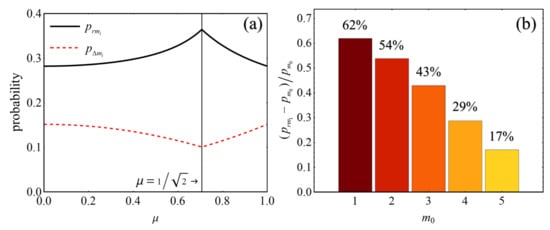
Figure 3.
(a) Relative detection probability and crosstalk probability of the signal photon versus initial probability amplitude (, ); (b) versus OAM quantum numbers ().
For OAM-based systems, information is encoded in the entire Hilbert space, where the turbulence effects, such as the fluctuations of the refractive index of the water flow [40], would cause the quantum state of photons to be partially transferred into other orthogonal complements, resulting in the mode scattering of OAM, or generally, the crosstalk, which is a disadvantage compared to polarization-based systems. The relative detection probability of a single photon and bi-photon entangled Airy beams are plotted in Figure 4, where we give no consideration to the trivial case according to Equation (1). For short-distance communication, as shown in Figure 4a,c, the signal still remains distinguishable for the crosstalk only existing on the immediately adjacent channels. As the propagation distance increases, for example, (as shown in Figure 4b,d), the crosstalk is conspicuous in all the observed channels. For large values of transmitted , oceanic turbulence makes the OAM state of the beam more prone to spread and the channel more vulnerable. Figure 4b,d shows that the OAM distribution of bi-photon entanglement for low-order OAM states is effectively enhanced in comparison with that of a single photon, while the phenomenon gradually disappears as the OAM number increases. With the increase in the initial , the gap between and in Hilbert space becomes larger. Thus the mutual transfer is much harder than that for a smaller . For example, , the probability of transferred to will probably be negligible, while the transition probability is an essential component of the in the case . This result also explains why the improvement in entanglement on the relative detection probability decreases with increases in OAM carried by an Airy beam in Figure 3b.
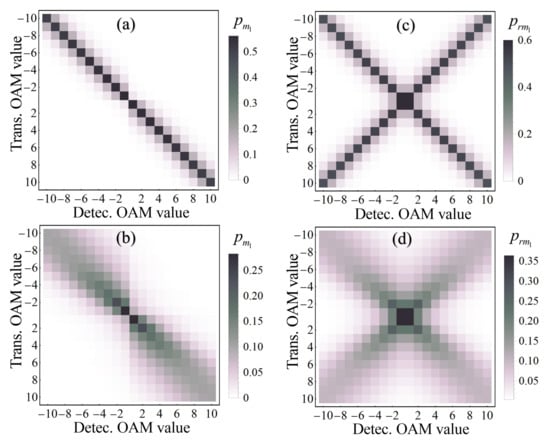
Figure 4.
Relative detection probability under oceanic turbulence of the single photon (a,b) and bi-photon entangled Airy beams (c,d) (for OAM, detections are plotted as the leading diagonal elements, while detections as the minor diagonal elements). With a propagation distance from (a,c), increasing to (b,d).
In a practical UOC system, parameter selection of the light source attracts extensive interest. Figure 5a shows the evolution of the relative detection probability as the propagation distance increases for different wavelengths . Here, the values of are selected from 417, 477 and 532 due to their small absorption loss under the sea. It can be seen from Figure 5a that increases with slightly. Airy beams with a shorter wavelength have a larger wave number that is more susceptible to turbulent fluctuations [41]. Moreover, we note that at propagation distance , the relative detection probabilities of different are approximately the same, which means that the communication wavelength could be equally optional at this distance. To investigate the effect of the main ring radius on the OAM of bi-photon entangled Airy beams, we plot Figure 5b. As increases from 1 to 5 , the detection probability rockets. The main ring radius determines the energy characteristics of Airy beams larger than corresponding to larger maximal intensity [42], thus elevating the detection probability. As we further increase to 25 , the probability becomes saturated. It indicates that the main ring radius of bi-photon entangled Airy beams and the design of the UOC system should be appropriately matched. While a larger main ring radius does not contribute to the increment of the detection probability, fewer fluctuations of detection probability are observed for a larger in . This effect is caused by the dispersion degree of the Airy beam being smaller so that the detection over different distances is more stable [43].
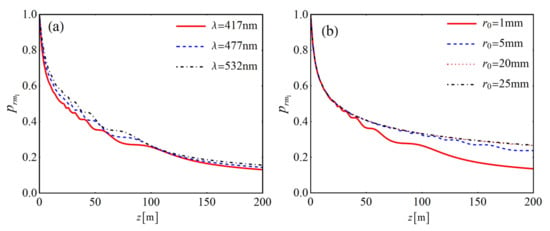
Figure 5.
Relative detection probability of signal photon versus propagation distance for different (a) wavelengths and (b) main ring radius .
The basic conditions of oceanic turbulence are essential for the design of an UOC system. Figure 6 illustrates the effect of the ratio of temperature and salinity contributions to the refractive index on the relative detection probability . Different from atmospheric turbulence, both temperature and salinity fluctuations are important factors in determining OAM transmission in oceanic turbulence. As varies from 0 to −5, the oceanic turbulence turns from salinity-induced dominated into temperature-induced dominated [9]. For the same distance, increases as approaches −5 and gains its maximum value at . Physically it reveals that the OAM of bi-photon entangled Airy beams will experience fewer adverse effects of turbulence in temperature-induced dominated oceanic turbulence than salinity-induced dominated oceanic turbulence.
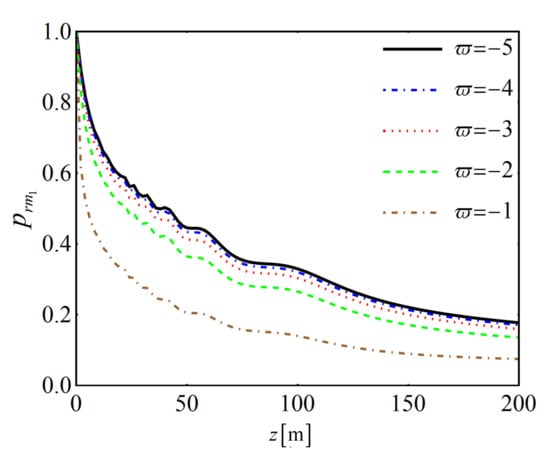
Figure 6.
Relative detection probability of signal photon versus propagation distance for different ratios of temperature and salinity contributions to the refractive index .
Except for the ratio , oceanic turbulence is also affected by turbulence factors, including , , and , whose influences on the entangled Airy beams are illustrated in Figure 7. Since our employed oceanic spectrum taking outer scale of turbulence into consideration agrees well with the experimental data in all wavenumber regions, we investigate the impacts of and on the OAM propagation. The outer- and the inner-scales define the scale sizes of turbulence eddies in the inertial range. The effective turbulence eddies in the inertial range would decrease with the increment of . Thus the beam scattering is reduced [12], corresponding to our result in Figure 7a, where increases when increases. By comparing and , we note that has less influence on OAM detection. Then, we demonstrate the relative detection probability against different dissipation rates of mean-squared temperature and different dissipation rates of turbulent kinetic energy per unit mass of fluid in Figure 7b. The probability decreases with increasing and decreasing . It generally illustrates that a larger and a smaller correspond to stronger oceanic turbulence and, thus, a smaller detection probability [14].
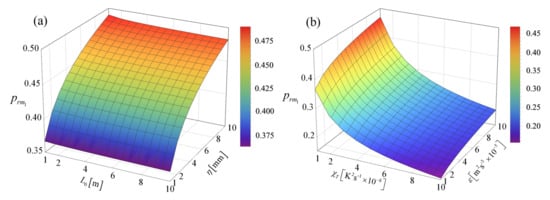
Figure 7.
Relative detection probability of signal photon under (a) different outer scale turbulences and inner-scale turbulences ; (b) different dissipation rates of mean-squared temperature and different dissipation rates of kinetic energy per unit mass of fluid ().
4. Conclusions
In this paper, we have proposed a theoretical model describing the OAM of bi-photon entangled Airy beams propagating through unstable stratifications of oceanic turbulence. We extend the theory of quantifying single photon OAM communication to obtain the relative detection probability in a bi-photon entangled case and express the bi-photon detection probability as two parts of a single photon detection probability. The analytical expression of the spatial coherence radius of a spherical wave in an unstably stratified oceanic turbulence is derived. Our results demonstrate that bi-photon entangled Airy beams obtain larger relative detection probability than non-entangled ones and are the largest for the maximally entangled case, which is caused by the modal transfer of the bi-photon. The order of Airy beams plays a key role in the detection. For low-order bi-photon entangled Airy beams, OAM entanglement effectively suppresses the crosstalk and improves the relative detection probability. The lowest-order modes of OAM carried by the bi-photon entangled Airy beams exhibit stronger resistance against oceanic turbulence. Consequently, up to a improvement is achieved over a distance of 100 m compared to the same measurement for the single photon system. To detect more initial OAM modes at receivers, bi-photon entangled Airy beams with a larger wavelength and main ring radius are preferable. Moreover, a larger main ring radius is also found to help reduce the fluctuations in the relative detection probability in oceanic turbulence. The discussions with respect to oceanic turbulence reveal that bi-photon entangled Airy beams in the turbulence of temperature-dominated fluctuations are less affected. The performance of a UOC system is related to oceanic turbulence with a larger inner-scale , larger dissipation rate of turbulent kinetic energy per unit mass of fluid and a smaller rate of the dissipation of mean-squared temperature . These findings may be useful in a UOC link based on the OAM of bi-photon entangled Airy beams.
In this work, we study the probability distribution of the entangled Airy beams in weak-strength turbulence. One of our future works will be to disclose how entangled Airy beams evolve in all strength regions of turbulence. The recent report that states that the auto-focus of Airy beam is reported to help reduce OAM crosstalk [31] will motivate the direction of our future work to investigate the interaction effects between auto-focus and entanglement.
Author Contributions
Conceptualization, D.Y., Y.Z. and Z.H.; methodology, D.Y. and Y.Z.; software, D.Y., Z.Y. and W.W.; validation, D.Y., Z.H. and Y.Z.; formal analysis, D.Y. and Y.Z.; investigation, D.Y.; resources, D.Y.; data curation, D.Y. and Z.Y.; writing—original draft preparation, D.Y.; writing—review and editing, D.Y., Z.H. and Y.Z.; visualization, D.Y., Z.Y. and W.W.; supervision, Z.H. and Y.Z.; project administration, Y.Z. All authors have read and agreed to the published version of the manuscript.
Funding
This research was funded by the National Natural Science Foundation of China (Grant No. 61701196, 61871202) and the Key Laboratory Open Fund of Quantum Information of CAS (KQI201).
Institutional Review Board Statement
Not applicable.
Informed Consent Statement
Not applicable.
Data Availability Statement
Not applicable.
Conflicts of Interest
The authors declare no conflict of interest.
References
- Baghdady, J.; Miller, K.; Morgan, K.; Byrd, M.; Osler, S.; Ragusa, R.; Li, W.; Cochenour, B.M.; Johnson, E.G. Multi-gigabit/s underwater optical communication link using orbital angular momentum multiplexing. Opt. Express 2016, 24, 9794–9805. [Google Scholar] [CrossRef] [PubMed]
- Chen, Y.; Shen, W.G.; Li, Z.M.; Hu, C.Q.; Quan, Y.; Jiao, Z.; Gao, J.; Cao, M.M.; Sun, K.; Jin, X.M. Underwater transmission of high-dimensional twisted photons over 55 meters. PhotoniX 2020, 1, 1–11. [Google Scholar] [CrossRef]
- Zhan, H.; Wang, L.; Wang, W.; Zhao, S. Experimental analysis of adaptive optics correction methods on the beam carrying orbital angular momentum mode through oceanic turbulence. Optik 2021, 240, 166990. [Google Scholar] [CrossRef]
- Wang, J.; Wang, X.; Peng, Q.; Zhao, S. Propagation characteristics of autofocusing Airy beam with power exponential phase vortex in weak anisotropic oceanic turbulence. J. Mod. Opt. 2021, 68, 1–7. [Google Scholar] [CrossRef]
- Andrews, L.C.; Phillips, R.L. Laser Beam Propagation Through Random Media; SPIE Digital Library: Bellingham, WA, USA, 2005. [Google Scholar]
- Yao, J.; Zhang, Y.; Wang, R.; Wang, Y.; Wang, X. Practical approximation of the oceanic refractive index spectrum. Opt. Express 2017, 25, 23283–23292. [Google Scholar] [CrossRef] [PubMed]
- Elamassie, M.; Uysal, M.; Baykal, Y.; Abdallah, M.; Qaraqe, K. Effect of eddy diffusivity ratio on underwater optical scintillation index. J. Opt. Soc. Am. A 2017, 34, 1969–1973. [Google Scholar] [CrossRef]
- Nikishov, V.; Nikishov, V. Spectrum of Turbulent Fluctuations of the Sea-Water Refraction Index. Int. J. Fluid Mech. Res. 2000, 27, 82–98. [Google Scholar] [CrossRef]
- Lu, W.; Liu, L.; Sun, J. Influence of temperature and salinity fluctuations on propagation behaviour of partially coherent beams in oceanic turbulence. J. Opt. A Pure Appl. Opt. 2006, 8, 1052–1058. [Google Scholar] [CrossRef]
- Lu, L.; Ji, X.; Baykal, Y. Wave structure function and spatial coherence radius of plane and spherical waves propagating through oceanic turbulence. Opt. Express 2014, 22, 27112–27122. [Google Scholar] [CrossRef]
- Ata, Y.; Baykal, Y. Effect of anisotropy on bit error rate for an asymmetrical Gaussian beam in a turbulent ocean. Appl. Opt. 2018, 57, 2258–2262. [Google Scholar] [CrossRef]
- Yu, L.; Zhang, Y. Analysis of modal crosstalk for communication in turbulent ocean using Lommel-Gaussian beam. Opt. Express 2017, 25, 22565–22574. [Google Scholar] [CrossRef] [PubMed]
- Chapter 8 Waters of the World Ocean—ScienceDirect. Elsevier Oceanogr. Ser. 1975, 11, 305–334.
- Li, Y.; Zhang, Y.; Zhu, Y. Oceanic spectrum of unstable stratification turbulence with outer scale and scintillation index of Gaussian-beam wave. Opt. Express 2019, 27, 7656–7672. [Google Scholar] [CrossRef]
- Jabir, M.V.; Anwar, A.; Samanta, G.K. Controlling the biphoton orbital angular momentum eigenmodes using asymmetric pump vortex beam. J. Opt. 2018, 21, 1–4. [Google Scholar] [CrossRef]
- Mair, A.; Vaziri, A.; Weihs, G.; Zeilinger, A. Entanglement of Orbital Angular Momentum States of Photons. Nature 2001, 412, 313–316. [Google Scholar] [CrossRef]
- Mafu, M.; Dudley, A.; Goyal, S.; Giovannini, D.; Mclaren, M.; Padgett, M.; Konrad, T.; Petruccione, F.; Lütkenhaus, N.; Forbes, A. Higher-dimensional orbital-angular-momentum-based quantum key distribution with mutually unbiased bases. Phys. Rev. A 2013, 88, 032305. [Google Scholar] [CrossRef]
- Walborn, S.; Oliveira, A.; Thebaldi, R.; Monken, C. Entanglement and conservation of orbital angular momentum in spontaneous parametric down-conversion. Phys. Rev. A 2005, 69, 023811. [Google Scholar] [CrossRef]
- Hamadou Ibrahim, A.; Roux, F.; Mclaren, M.; Konrad, T.; Forbes, A. Orbital angular momentum entanglement in turbulence. Phys. Rev. A 2013, 88, 012312. [Google Scholar] [CrossRef]
- Krenn, M.; Handsteiner, J.; Fink, M.; Fickler, R.; Zeilinger, A. Twisted photon entanglement through turbulent air across Vienna. Proc. Natl. Acad. Sci. USA 2015, 112, 14197–14201. [Google Scholar] [CrossRef]
- Karpov, E.; Daems, D.; Cerf, N. Entanglement-enhanced classical capacity of quantum communication channels with memory in arbitrary dimensions. Phys. Rev. A 2006, 74, 032320. [Google Scholar] [CrossRef]
- Ecker, S.; Bouchard, F.; Bulla, L.; Brandt, F.; Kohout, O.; Steinlechner, F.; Fickler, R.; Malik, M.; Guryanova, Y.; Ursin, R.; et al. Overcoming Noise in Entanglement Distribution. Phys. Rev. X 2019, 9, 041042. [Google Scholar] [CrossRef]
- Bouchard, F.; Fickler, R.; Boyd, R.; Karimi, E. High-dimensional quantum cloning and applications to quantum hacking. Sci. Adv. 2017, 3, e1601915. [Google Scholar] [CrossRef] [PubMed]
- Ma, H.; Qiao, Y.; Liu, H.; Shen, C. Numerical study of orbital angular momentum-entanglement in turbulence with adaptive optics system compensation. Appl. Phys. B 2018, 124, 1–9. [Google Scholar] [CrossRef]
- Leonhard, N.D.; Shatokhin, V.N.; Buchleitner, A. Universal entanglement decay of photonic-orbital-angular-momentum qubit states in atmospheric turbulence. Phys. Rev. A 2015, 91, 012345. [Google Scholar] [CrossRef]
- Yang, Y.; Yang, D.; Wang, J.; Zhu, Y.; Hu, Z.; Zhang, Y. Non-Kolmogorov atmospheric turbulence and orbital angular momentum of entangled states for optical communication. Results Phys. 2019, 15, 102676. [Google Scholar] [CrossRef]
- Berry, M.V.; Balazs, N.L. Nonspreading wave packets. Am. J. Phys. 1979, 47, 264–267. [Google Scholar] [CrossRef]
- Zhang, P.; Prakash, J.; Zhang, Z.; Mills, M.; Efremidis, N.; Christodoulides, D.; Chen, Z. Trapping and guiding microparticles with morphing autofocusing Airy beams. Opt. Lett. 2011, 36, 2883–2885. [Google Scholar] [CrossRef]
- Broky, J.; Siviloglou, G.; Dogariu, A.; Christodoulides, D. Self-healing properties of optical Airy beams. Opt. Express 2008, 16, 12880–12891. [Google Scholar] [CrossRef]
- Chu, X.; Zhou, G.; Chen, R.P. Analytical study of the self-healing property of Airy beams. Phys. Rev. A 2012, 85, 013815. [Google Scholar] [CrossRef]
- Yue, P.; Hu, J.; Yi, X.; Xu, D.; Liu, Y. Effect of Airy Gaussian vortex beam array on reducing intermode crosstalk induced by atmospheric turbulence. Opt. Express 2019, 27, 37986–37998. [Google Scholar] [CrossRef]
- Yan, X.; Liang, S.; Li, J.; Guo, L. Mitigating Vortex Splitting by Controlling the Wavefront Isophase Line Curvature of Vector Autofocusing Airy Vortex Beams in Free Space. Photonics 2022, 9, 325. [Google Scholar] [CrossRef]
- Lib, O.; Bromberg, Y. Spatially entangled Airy photons. Opt. Lett. 2020, 45, 1399–1402. [Google Scholar] [CrossRef] [PubMed]
- Yang, D.; Hu, Z.D.; Wang, S.; Zhu, Y. Influence of random media on orbital angular momentum quantum states of optical vortex beams. Phys. Rev. A 2022, 105, 053513. [Google Scholar] [CrossRef]
- Gopaul, C.; Andrews, R. The effect of atmospheric turbulence on entangled orbital angular momentum states. New J. Phys. 2007, 9, 94. [Google Scholar] [CrossRef]
- Paterson, C. Atmospheric Turbulence and Orbital Angular Momentum of Single Photons for Optical Communication. Phys. Rev. Lett. 2005, 94, 153901. [Google Scholar] [CrossRef]
- Siviloglou, G.; Christodoulides, D. Accelerating finite energy Airy beams. Opt. Lett. 2007, 32, 979–981. [Google Scholar] [CrossRef]
- Chu, X. Evolution of an Airy beam in turbulence. Opt. Lett. 2011, 36, 2701–2703. [Google Scholar] [CrossRef]
- Zhang, X.; Shen, B.; Shi, Y.; Wang, X.; Zhang, L.; Wang, W.; Xu, J.; Yi, L.; Xu, Z. Generation of Intense High-Order Vortex Harmonics. Phys. Rev. Lett. 2014, 114, 173901. [Google Scholar] [CrossRef]
- Cheng, M.; Guo, L.; Li, J.; Zhang, Y. Channel Capacity of the OAM-Based Free-Space Optical Communication Links With Bessel–Gauss Beams in Turbulent Ocean. IEEE Photonics J. 2016, 8, 1–11. [Google Scholar] [CrossRef]
- Zhu, Y.; Zhang, Y.; Hu, Z. Spiral spectrum of Airy beams propagation through moderate-to-strong turbulence of maritime atmosphere. Opt. Express 2016, 24, 10847–10857. [Google Scholar] [CrossRef]
- Efremidis, N.; Christodoulides, D. Abruptly autofocusing waves. Opt. Lett. 2010, 35, 4045–4047. [Google Scholar] [CrossRef] [PubMed]
- Wang, X.; Yang, Z.; Zhao, S. Influence of oceanic turbulence on propagation of Airy vortex beam carrying orbital angular momentum. Optik 2018, 176, 49–55. [Google Scholar] [CrossRef]
Publisher’s Note: MDPI stays neutral with regard to jurisdictional claims in published maps and institutional affiliations. |
© 2022 by the authors. Licensee MDPI, Basel, Switzerland. This article is an open access article distributed under the terms and conditions of the Creative Commons Attribution (CC BY) license (https://creativecommons.org/licenses/by/4.0/).
